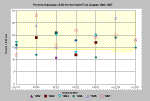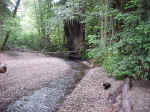Bibliography Background About KRIS
Hypothesis #2: Elevated levels of sediment in the Gualala River limit coho salmon and steelhead trout production.
Support for the Hypothesis
McNeil and Ahnell (1964) described the relationship between increasing fine sediment and decreased salmon spawning success. They recognized that fines less than 0.833 mm intruded into nests and suffocated eggs and also that this fraction of sediment was highly mobile and could be washed downstream by flushing flows. McHenry et al. (1994) found that, when fine sediment levels less than 0.85 mm reach 13% inside redds, there is almost no coho salmon or steelhead egg survival. Barnard (1992) found that fine sediment (<1 mm) comprised, on average, just 13% of the streambed of Freshwater Creek, after 50 years of watershed rest. Fine sediment (<0.85 mm) data collected by Gualala Redwoods, Inc. in the North Fork Gualala basin show that values have exceeded 20% between 1995 and 1997 at almost all stations (Figure 1). The sampling variability for fine sediment (standard error) could not be calculated for McNeil data because raw data were not available.
 Figure 1. North Fork Gualala McNeil sample results for fine sediment less than 0.85 mm from 1992 to 1997 are displayed at left. Data at Little North Fork sites (lnf202 and lnf255) show that both stations had fine sediment levels suitable for salmonid spawning (12%) as of 1992, but levels then rose to 22% and 28%, respectively, and McGann Creek (mcg) had 26% in 1996. While sediment levels were lower on Dry, Robinson (rob) and Doty (doty) creeks, all stations had fine sediment levels that would limit salmonid egg and alevin survival.
Figure 1. North Fork Gualala McNeil sample results for fine sediment less than 0.85 mm from 1992 to 1997 are displayed at left. Data at Little North Fork sites (lnf202 and lnf255) show that both stations had fine sediment levels suitable for salmonid spawning (12%) as of 1992, but levels then rose to 22% and 28%, respectively, and McGann Creek (mcg) had 26% in 1996. While sediment levels were lower on Dry, Robinson (rob) and Doty (doty) creeks, all stations had fine sediment levels that would limit salmonid egg and alevin survival.
Reeves et al. (1993) found that Pacific salmon species diversity in Oregon coastal streams dropped after logging, when excessive sediment filled pools and decreased habitat diversity. Brown et al. (1994) point out that coho salmon prefer pools at least one meter deep. Reeves (1988) found that steelhead required pool habitat deeper than three feet as yearlings. Boydstun (1977) found that most Gualala River steelhead that survived to adulthood migrated to sea as two-year old fish. Sediment supply in the Gualala basin is so high that that there are few pools three feet in depth (Figure 2), even in higher order streams, according to California Department of Fish and Game habitat typing surveys conducted in 2001 (California Resources Agency, In review). This indicates a lack of carrying capacity for older age steelhead juveniles, which likely translates into lower recruitment into the adult population. Pool depth is the most objective and repeatable metric gathered during habitat typing data.
 Figure 2. This chart shows maximum pool depths measured during 2001 CDFG habitat surveys of the Gualala River. Streams surveyed are ranked by stream order from top to bottom in the chart. The vast majority of pools are less than three feet deep in Gualala tributaries, including the largest streams (North Fork and Wheatfield). Only two of 104 pools measured in the South Fork Gualala were over three feet deep. The lack of pool depth indicates diminished rearing habitat capability for salmonids resulting from high sediment supply.
Figure 2. This chart shows maximum pool depths measured during 2001 CDFG habitat surveys of the Gualala River. Streams surveyed are ranked by stream order from top to bottom in the chart. The vast majority of pools are less than three feet deep in Gualala tributaries, including the largest streams (North Fork and Wheatfield). Only two of 104 pools measured in the South Fork Gualala were over three feet deep. The lack of pool depth indicates diminished rearing habitat capability for salmonids resulting from high sediment supply.
CDFG 2001 habitat surveys also found that extensive reaches of the Gualala River and its tributaries lacked surface flow (Figure 3). Many of these reaches formerly supported salmonid juveniles in summer, but high sediment yield has buried these productive reaches. Measurement of dry stream reaches is also robust since there is no chance for introduction of observer bias. Hope (2001) noted that salmonid habitat was being significantly decreased by sediment in the Little North Fork Gualala basin (Figure 4).
 Figure 3. The image at left shows CDFG habitat typing results displayed as habitat frequency by length for the western Gualala Basin. Note dry reaches in Robinson Creek, Dry Creek, lower Rockpile Creek, the Wheatfield Fork and the lower South Fork Gualala below Big Pepperwood Creek. When sediment supply is so high that streams lose surface flow, it diminishes carrying capacity for salmonid juveniles. Counties and Calwater Planning Watersheds are also displayed for reference.
Figure 3. The image at left shows CDFG habitat typing results displayed as habitat frequency by length for the western Gualala Basin. Note dry reaches in Robinson Creek, Dry Creek, lower Rockpile Creek, the Wheatfield Fork and the lower South Fork Gualala below Big Pepperwood Creek. When sediment supply is so high that streams lose surface flow, it diminishes carrying capacity for salmonid juveniles. Counties and Calwater Planning Watersheds are also displayed for reference.
 Figure 4. The image at left shows the Little North Fork Gualala River just upstream of the North Fork. Note the water and batter marks on the clump of redwoods in the photo. This large amount of gravel is plugging the Little North Fork channel and reducing pool frequency and depth. Hope (2001) also found that aggradation was causing increased peak flows that were damaging riparian trees.
Figure 4. The image at left shows the Little North Fork Gualala River just upstream of the North Fork. Note the water and batter marks on the clump of redwoods in the photo. This large amount of gravel is plugging the Little North Fork channel and reducing pool frequency and depth. Hope (2001) also found that aggradation was causing increased peak flows that were damaging riparian trees.
The following is a listing of topics and maps from the KRIS Gualala database and the KRIS Gualala Map project that are used in the arguments above. Viewing them in context allows access to data, Metadata and associated Info Links. The large-case letters in parentheses indicate KRIS Gualala sub-basins.
(NF) Sediment: Percent Substrate <0.85 mm Values for NF Gualala Sites
(MG) Habitat: Maximum Pool Depths (All)
Fish and Aquatics View: KRIS Gualala Map project.
(NF) Tour: Little NF & NF Gualala Photos of Channel 2001 #1
Alternative Hypothesis
Stream bed sediment measurements are insufficient to gauge trends because of sample size and variability. The samples also may be in the range of natural or background levels and not injurious to salmonids. O'Connor (2002), in comments on the draft KRIS Gualala database, stated that: "historic or natural levels of fine sediment in the bed are unknown" and that "the presence of gravel-textured deposits in the lower reaches of Gualala River tributaries is ordinary and expected; why is this construed as detrimental to fish habitat?"
Monitoring Trends to Support or Refute the Hypothesis
Establish a monitoring program to check trends in pool depth, sediment in pools (V*) and standing crops of juvenile salmonids. Check for increasing or decreasing trends in coho and steelhead numbers as pool volumes fluctuate. If coho salmon and/or steelhead trout juveniles increase with increasing pool depth, it would support the hypothesis. (Necessary to consider confounding factors such as high water temperature, varying levels of large wood or cover, etc.). The fish might also re-express without reduction of sediment if ocean conditions or other factors have been confounding recovery.
Monitor trends in fine sediment adjacent to coho or steelhead redds in various Gualala River tributaries using McNeil samples or freeze cores, similar to Barnard (1992), then use nets over the redds to capture emerging fry. Relationships between fines and survival to emergence would support the hypothesis. In addition, scour chains could be used to measure bedload mobility (Nawa and Frissell, 1993) to test whether bedload movement is likely affecting spawning success.
Monitoring to test the weight of evidence for this hypothesis could be part of TMDL implementation: 1) implement erosion control measures, 2) monitor sediment (V*, McNeil samples, turbidity) and, 3) track coho and steelhead response with fish sampling.
References
Barnard, 1992. Physical and Chemical Conditions in Coho Salmon (Oncorhynchus kisutch) Spawning Habitat in Freshwater Creek, Northern California. Masters Thesis. Humboldt State University, Arcata, CA. 81 p. plus appendices.
Boydstun, L.B. 1977. California's steelhead program. in T. Hassler and R. Van Kirk, eds. Proceedings of the genetic implications of steelhead management symposium, 1977. Calif. Coop. Fish. Res. Unit special report 77-1. pp. 26-30.
Brown, L.R., P.B. Moyle and R.M. Yoshiyama, 1994. Historical Decline and Current Status of Coho Salmon in California. North American Journal of Fisheries Management. 14( 2) 237-261.
California Regional Water Quality Control Board (CRWQCB). 2001. Technical Support Document for the Gualala River Watershed Water Quality Attainment Action Plan for Sediment. CRWQCB, Region 1. Santa Rosa, CA. 147 pp.
California Resources Agency. In Review. Gualala River Watershed Synthesis. CA Dept. of Fish and Game, State Water Res. Control Bd., CA Dept. of Water Resources, CA Div. on Mines and Geology and CA Dept. of Forestry. Sacramento, CA. Draft released January 16, 2001.
California Regional Water Quality Control Board (CRWQCB). 2001. Little North Fork Pre-Harvest Inspection. North Coast Regional Water Quality Control Board, Santa Rose, CA. 24 p.
McHenry, M.L., D.C. Morrill and E. Currence. 1994 . Spawning Gravel Quality, Watershed Characteristics and Early Life History Survival of Coho Salmon and Steelhead in Five North Olympic Peninsula Watersheds. Lower Elwha S'Klallam Tribe, Port Angeles, WA. and Makah Tribe, Neah Bay, WA. Funded by Washington State Dept. of Ecology (205J grant).
McNeil, W. J. and W.H. Ahnell. 1964. Success of Pink Spawning Relative to Size of Spawning Bed Material. U.S. Fish and Wildlife Service, Special Scientific Report - Fisheries No. 469. Washington, D.C. 17 pp.
O'Connor, M. 2002. Comments on the Draft KRIS Gualala project. Performed on behalf of the Gualala River Watershed Council. O'Connor Environmental, Healdsburg, CA. 4 p.
Nawa, R.K., C.A. Frissell and W.J. Liss. 1990. Life history and persistence of anadromous salmonid stocks in relation to stream habitats and watershed classification, annual progress report (4/18/90). Prepared for Oregon Department of Fish and Wildlife, by Oak Creek Laboratory of Biology, Department of Fisheries and Wildlife, Corvallis, OR.
Nawa, R.K. and C.A. Frissell. 1993. Measuring Scour and Fill of Gravel Streambeds with Scour Chains and Sliding-Bead Monitors. North American Journal of Fisheries Management 13(3):634-639.
Reeves, G.H.1988. Distribution patterns of fish in the Elk River basin. COPE Report l(3): 4-6.